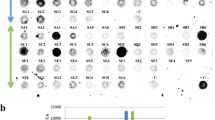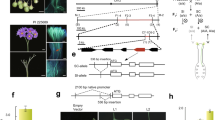Abstract
We efficiently transformed the commercial cultivars of potato (Solanum tuberosum) Bintje, Desiree and Escort after optimizing the conditions for regeneration from potato tuber discs. For transformation, tuber discs were cocultivated with Agrobacterium tumefaciens using a disarmed binary vector system. This system allowed the introduction of a chimaeric gene encoding the coat protein (CP) of potato virus X (PVX) into two cultivars most susceptible to this virus, Bintje and Escort. Five transgenic plant lines with expression levels of CP higher than 0.1% of soluble leaf protein were analyzed for resistance to a challenging inoculation with PVX (1 μg/ml). We observed a delay in symptom development as well as a drastic reduction in the accumulation of virus. Furthermore, we found a correlation between the expression level of the CP–gene and the reduction in virus accumulation. Cytogenetic analysis of 62 independently obtained transgenic lines showed the normal tetraploid number of chromosomes (2n = 4x = 48) in 97 percent of the examined plants. Phenotypically all these plants appeared normal. One plant line exhibited an abnormal phenotype and contained about the octaploid number of chromosomes (4n ≈ 8x = 96). These results and preliminary data on morphological characteristics, as these are determined in the official variety registration procedure, indicate that potato cultivars can be genetically engineered to contain new desirable traits with preservation of their intrinsic properties.
This is a preview of subscription content, access via your institution
Access options
Subscribe to this journal
Receive 12 print issues and online access
$209.00 per year
only $17.42 per issue
Buy this article
- Purchase on Springer Link
- Instant access to full article PDF
Prices may be subject to local taxes which are calculated during checkout
Similar content being viewed by others
References
Horsch, R.B., Fry, J.E., Hoffmann, N., Wallroth, M., Eichholtz, D., Rogers, S.G., and Fraley, R.T. 1985. A simple and general method for transferring genes into plants. Science 227:1229–1231.
McCormick, S., Niedermeyer, J., Fry, J., Barnason, A., Horsch, R., and Fraley, R. 1986. Leaf disc transformation of cultivated tomato (L. esculentum) using Agrobacterium tumejanens. Plant Cell Reports 5:81–84.
Fillatti, J.J., Kiser, J., Rose, R., and Comai, L. 1987. Efficient transfer of a glyphosate tolerance gene into tomato using a binary Agrobacterium tumefaciens vector. Bio/Technology 5:726–730.
Ooms, G. and Lenton, J.R. 1985. T-DNA genes to study plant development: precocious tuberisation and enhanced cytokinins in A. tumefaciens transformed potato. Plant Mol. Biol. 5:205–212.
Ooms, G., Karp, A., and Roberts, J. 1983. From tumour to tuber; tumour cell characteristics and chromosome numbers of crown gall-derived tetraploid potato plants (Solarium luberosum cv. Maris Bard). Theor. Appl. Gen 66:169–172.
Ooms, G., Burrell, M.M., Karp, A., Bevan, M., and Hille, J. 1987. Genetic transformation in two potato cultivars with T-DNA from disarmed Agrobacterium. Theor. Appl. Gen. 73:744–750.
Sheerman, S. and Bevan, M.W. 1988. A rapid transformation method for Solanum tuberosum using binary Agrobacterium tumefaciens vectors. Plant Cell Reports 7:13–16.
Stiekema, W.J., Heidekamp, F., Louwerse, J.D., Verhoeven, H.A., and Dijkhuis, P. 1988. Introduction of foreign genes into potato cultivars Bintjc and Desiree using an Agrobacterium tumefaciens binary vector. Plant Cell Reports 7:47–50.
Karp, A., Nelson, R.S., Thomas, E., and Bright, S.W.J. 1982. Chromosome variation in protoplast derived potato plants. Theor. Appl. Genet. 63:265–272.
Gill, B.S., Kam-Morgan, L.M.W., and Shepard, J.F. 1987. Cytogenetic and phenotypic variation in mesophyll cell derived tetraploid potatoes. J. Heredity 78:15–20.
Stols, A.L.H., Hill-Van der Meulen, G.W., and Toen, M.K.I. 1970. Electron microscopy of Nicotiana glutmosa leaf cells infected with potato virus X. Virology 40:168–170.
Sonenberg, N., Shatkin, A.J., Riccardi, R.P., Rubin, M., and Goodman, R.M. 1978. Analysis of terminal structures of RNA from potato virus X. Nucleic Acids Research 5:2501–2521.
Morozov, S., Yu, Zakchariev, V.M., Chernow, B.K., Prasolov, V.S., Koslov, Yu.V., Atabekov, J.G., and Skryabin, K.G. 1983. The analysis of the primary structure and localization of the coat protein gene on the genomic RNA of potato virus X. Dokladi Academi Nauk SSSR 271:211–215 (In Russian).
Huisman, M.J., Linthorst, H.J.M., Bol, J.F., and Cornelissen, B.J.C. 1988. The complete nucleotidc sequence of potato virus X reveals homologies at the amino acid level with various plus-stranded RNA viruses. J. Gen. Virol. 69:1789–1798.
Powel Abel, P., Nelson, R.S., De, B., Hoffmann, N., Rogers, S.G., Fraley, R.T., and Beachy, R.N. 1986. Delay of disease development in transgenic plants that express the lobacco mosaic virus coat protein gene. Science 232:738–743.
Loesch-Fries, L.S., Merlo, D., Zinnen, T., Burhop, L., Hill, K., Krahn, K., Jarvis, N., Nelson, S., and Halk, E. 1987. Expression of alfalfa mosaic virus RNA 4 in transgenic plants confers virus resistance. EMBO J. 6:1845–1851.
Turner, N.E., O'Connell, K.M., Nelson, R.S., Sanders, P.R., Beachy, R.N., Fraley, R.T., and Shah, D.M. 1987. Expression of alfalfa mosaic virus coal protein gene confers cross protection in transgenic tobacco and tomato plants. EMBO J. 6:1181–1188.
Van Dun, C.M.P., Bol, J.F., and Van Vloten-Doting, L. 1987. Expression of alfalfa mosaic virus and tobacco rattle virus coat protein genes in transgenic tobacco plants. Virology 159:299–305.
Hemenway, C., Fang, R.X., Kaniewski, W., Chua, N.H., and Turner, N.E. 1988. Analysis of the mechanism of protection in transgenic plants expressing the potato virus X coat protein or its antisense RNA. EMBO J. 7:1273–1280.
Cuozzo, M., O'Connell, K.M., Kaniewski, W., Fang, R.X., Chua, N.H., and Tumer, N.E. 1988. Viral protection in transgenic tobacco plants expressing the cucumber mosaic virus coat protein or its antisense RNA. Bio/Technology 6:549–557.
Deblaere, R., Bytebier, B., De Greve, H., Deboeck, F., Schell, J., Van Montagu, M., and Leemans, J. 1985. Efficient octopine Ti plasmidderived vectors for Agrobacterium mediated gene transfer to plants. Nucleic Acids Research 13:4777–4788.
Baulcombe, D.C., Saunders, G.R., Bevan, M.W., Mayo, M.A., and Harrison, B.D. 1986. Expression of biologically active viral satellite RNA from the nuclear genome of transformed plants. Nature 321:446–449.
Murashige, T. and Skoog, F. 1962. A revised medium for rapid growth and bioassays with tobacco tissue cultures. Physiol. Plant 15:473–497.
Hoekcma, A., Hirsch, P.R., Hooykaas, P.J.J., and Schilperoort, R.A. 1983. A binary plant vector strategy based on separation of vir- and T-region of the Agrobacterium tumefaciens Ti-plasmid. Nature 303:179–180.
Ditta, G., Stanfield, S., Corbiu, D., and Helmski, D. 1980. Broad host range DNA cloning system for gram-negative bacteria: construction of a genebank of Rhizobium meliloti. Proc. Natl. Acad. Sci. USA 77:7347–7351.
Bevan, M.W., Flavell, R.B., and Chilton, M.-D. 1983. Chimacric antibiotic resistance gene as a selectable marker for plant cell transformation. Nature 304:184–187.
Fraley, R.B., Rogers, S.G., Horsch, R.B., Sander, P.S., Flick, J.S., Adams, S.P., Bittner, M.L., Brand, L.A., Fink, C.L., Fry, J.S., Gallupi, R., Goldberg, S.B., Hoffman, N.L., and Woo, S.C. 1983. Expression of bacterial genes in plant cells. Proc. Natl. Acad. Sci. USA 80:4803–4807.
Hooykaas, P.J.J., Klapwijk, P.M., Nuti, M.D., Schilperoort, R.A., and Rorsch, A. 1977. Transfer of the Agrobactenum tumefaciens Ti-plasmid to avirulent agrobacteria and to Rhiwbium ex plants. J. Gen. Microbiol. 98:477–484.
Stachel, S.E., Messens, E., Van Montagu, M., and Zambryski, P. 1985. Identification of the signal molecules produced by wounded plant cells that activate T-DNA transfer in Agrobacterium tumefaciens. Nature 318:624–629.
Reiss, B., Sprengel, R., Will, H., and Schaller, H. 1984. A new sensitive method for qualitative and quantitative assay of neomycin phospho-transferasc in crude cell extracts. Gene 30:217–223.
Bradford, M.M. 1976. A rapid and sensitive method for the quantitation of microgram quantities of proteins utilizing the principle of protein-dye binding. Anal. Biochem. 72:248–254.
Dunsmuir, P., Smith, S.M., and Bedbrook, J. 1983. The major chlorophyll a/b-binding protein of Petunia is composed of several polypeptides encoded by a number of distinct nuclear genes. J. Mol. Appl. Genet. 2:285–300.
Laemmli, U.K. 1970. Cleavage of structural proteins during the assembly of the head of bactcriophage T4. Nature 227:680–685.
UPOV, 1986. International Union for the protection of new varieties of plants. Guidelines for the conduct of tests for distinctness, homogeneity and stability of potato (Solanum luberosum)
Author information
Authors and Affiliations
Rights and permissions
About this article
Cite this article
Hoekema, A., Huisman, M., Molendijk, L. et al. The Genetic Engineering of Two Commercial Potato Cultivars for Resistance to Potato Virus X. Nat Biotechnol 7, 273–278 (1989). https://doi.org/10.1038/nbt0389-273
Received:
Accepted:
Issue Date:
DOI: https://doi.org/10.1038/nbt0389-273
This article is cited by
-
Endogenous auxin level is a critical determinant for in vitro adventitious shoot regeneration in potato (Solanum tuberosum L.)
Journal of Plant Biochemistry and Biotechnology (2012)
-
Field testing, gene flow assessment and pre-commercial studies on transgenic Solanum tuberosum spp. tuberosum (cv. Spunta) selected for PVY resistance in Argentina
Transgenic Research (2012)
-
Functional stacking of three resistance genes against Phytophthora infestans in potato
Transgenic Research (2012)
-
Resistance to multiple viruses in transgenic tobacco expressing fused, tandem repeat, virus-derived double-stranded RNAs
Virus Genes (2011)
-
Direct and efficient plant regeneration from leaf explants of Solanum tuberosum l. cv. Bintje
Plant Cell Reports (1995)



